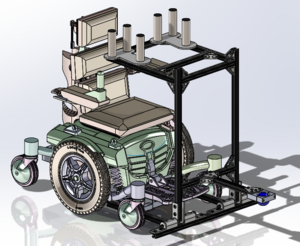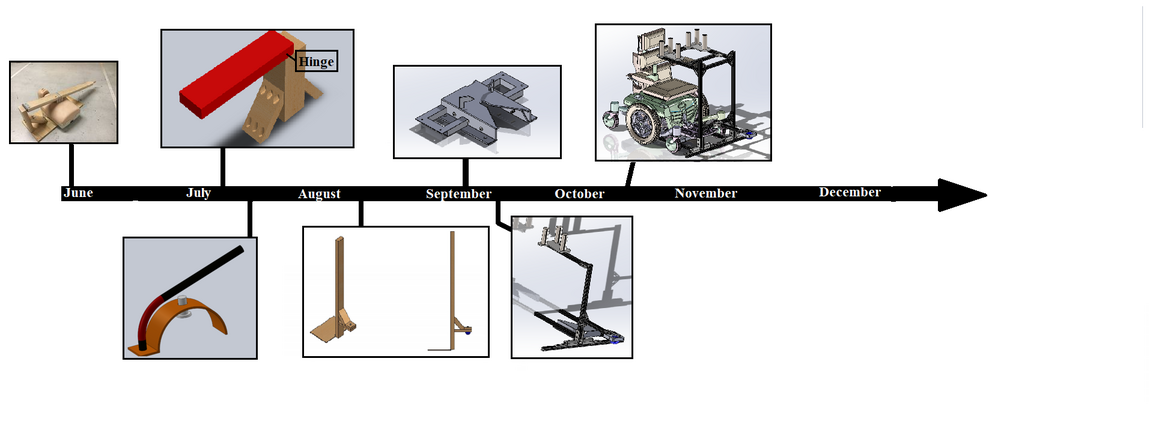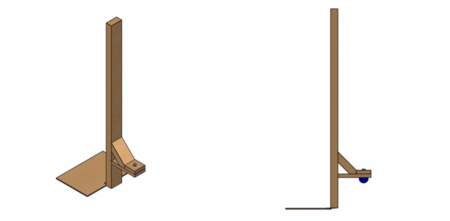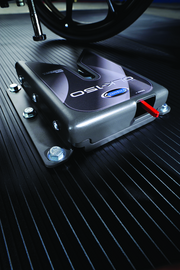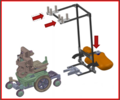Assistive CPR Device
| 2020 Engineering Capstone Project | |
| Duration | Summer 2020 - Fall 2020 |
| Team Name | 120CCs |
| Members |
|
| Faculty Adviser |
|
| Mentor |
|
| Sponsors |
|
| Client |
|
CPR is an acronym for Cardiopulmonary Resuscitation, an emergency procedure that is used to preserve brain function through artificially circulating the blood through the body. Conducting CPR is a physically demanding procedure that requires special training. The purpose of this project is to make CPR simpler and less physically demanding, allowing for our physically challenged client to successfully perform CPR. Eventually, we hope that this device can be adapted or inspire future iterations that would allow others with disabilities to perform this life saving technique.
Background[edit | edit source]
CPR is an important life saving technique for victims who can not breath as well as those suffering from cardiac arrest. In statistics posted by the American Heart Association, having a bystander who can perform CPR improves the victims survival rate by almost 45 percent.
For this project, 120CCs were recruited to design a device that would assist a medical student with a disability conduct CPR. With a final goal of helping them pass their CPR examination to further progress into the medical field, as well as empower them and others with similar ailments to pursue their dreams in the medical field.
120CCs design team has acquired a CPR training mannequin to use for testing both prototype and final designs. Additionally, 120CCs will be using a volunteer to test if the design will provide mechanical assistance for physically challenged individuals.
Specifications[edit | edit source]
The Assistive CPR device needs to meet several design specifications in order to be both practical and usable for emergency medical situations.
- The Device must be compliant with American Heart Association Guidelines.
- The Device must be able to compress the chest a minimum of 5 cm to a maximum of 6 cm.
- The device should use a force multiplication system to help physically weaker individuals apply the necessary force and pressure to compress the chest a minimum and maximum depth.
- The Device should be portable and easily stored for quick access/use during a medical emergency.
- The Device must fit an average human as well as be easily maneuverable to apply compressions to the proper location on the sternum.
- The Device must withstand 1,000 hours of use without structural damage.
- The Device must be lightweight and easily deployable with a mechanized wheelchair.
Design Development[edit | edit source]
Initial Designs[edit | edit source]
As part of a physician’s medical education, the student must earn CPR certification. This can be problematic for those with different abilities. The WWAMI Medical Program at the University of Idaho is interested in developing a device that people with minimal physical strength can use to provide necessary chest compression. The device would be used on people suffering from cardiac events, in locations such as assisted care facilities and rest homes We envision that someone in a wheelchair could move and position the device, then add the force required. The device must therefore be lightweight and easily deployed. Mannequins, provided by the WWAMI program, will be used to test the device. The design team will work with WWAMI program participants to understand the design constraints, test, refine, and fabricate the device."-WWAMI Design Statement. To be more specific the device needed to be operable from a wheelchair. Our client, a quadrapolegic, needed to beable to use the device to administer CPR with minimal strength. The team did not initially have this information, until after developing the Spring Jack Design. The designs developed post Spring Jack took into account our clients situation.
Design Implementation and Improvements[edit | edit source]
During a meeting with the WWAMI medical student, they mentioned that they use a mechanism in their car to lock their wheelchair into place behind the steering wheel to allow them to safely drive their car. This system, is colloquially called the EZ-Lock System. It is used widely to allow for operation of a vehicle from a wheel chair. We thought this device could be a good base for integrating the Rotating Arm Device into the student's wheel chair. If all goes according to plan this will allow the student to "dock" into the Assistive CPR Device and subsequently manipulate it with their wheel chair.
This design met all requirements of storage limitations, maneuverability as well as lightness and ease of use for the client. The device also provided enough mechanical advantage to apply approximately 100-120 lbf to the sternum of the mannequin.
80/20 Prototype[edit | edit source]
Inspired by the Q-Straint locking mechanism, the 120CCs moved forward to create the body of the mechanism. Given the success of the “wheel chair box lever design” in initial tests, few modifications were necessary to to create a device that would assist our client.
For the secondary prototype 120CCs turned to the manufacturer of 80/20 to supply them with material both rigid and adaptable enough to create the design. Each piece of 80/20 is made up of annealable 6105-T5 aluminum alloy, and has earned the moniker of “the industrial erector set” because of its versatility. This versatility of the material has allowed the team to address a consistent question of adjustability. With at little as a slide the mechanism can be raised and lowered to suit different widths of the patient and applicator. Although this is not a perfect emergency situation level adjustment, it does place the group in the right direction. For the second prototype, a Y-axis hinge was attached to the compression lever, in order to help maintain full lateral energy when performing compressions on the dummy.
Prototype Testing[edit | edit source]
Disclaimer:Due to HIPPA Privacy policy, images of the client testing the device are not posted to the page. All other testing of applications were taking with video and not availble to be embedded at this time.
The initial testing involed the wood prototype as a proof of concept. Using a bluetooth CPR manequin that pairs with the QCPR Training App, the team tested the force of each compression and if full compressions at a rate of 100-120 compressions per minute. The wooden prototype proved incredibly effective and with unanimous agreement agreed to design the next device for our client to use.
The first fully metal mechanical device, shown above as the singular arm lever device, displayed large amounts of torsional force about the moment arm, as well as a measurable amount of instability. The team found that the force output assembly, attached to the horizontal railing, was subject to the majority of the torsional force from the oscillating compressions. With this concern in mind, the team set about calculating the stresses on the various railing components to estimate the level at which the mechanism would fail. Given the bending stress on the rail is 18 ksi, and UTS (ultimate tensile strength) of 80/20 is 38ksi, the calculated factor of safety was 2.1. Leading to the team to develop the device portrayed
Design Validation[edit | edit source]
Attached in the files below is a PDF of the groups Design validation plan. This plan details both the required tests, outcome, and suggested corrective action if necessary. Most tests were conducted with the group inorder to achieve a testable 80% effective device for testing with the client. Future stablization is necessary for the device to be 100% effective. With force reflection from the manequin overpowering 120CCs 3 point contact attachment.
Team Members[edit | edit source]
| Josh Sewell
Major: Mechanical Engineering | ||
| Abdulrahman Almajnouni
Major: Mechanical Engineering | ||
| Ahmed Al Nahab
Major: Mechanical Engineering | ||
| Ty Newman
Major: Material Science Engineering |
